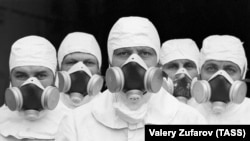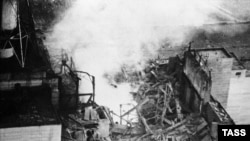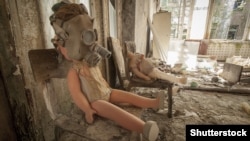The buses are lined up by midmorning, packed with tourists anxious to enter one of the world's most infamous attractions. The excitement is lost on members of the 633rd Fire Brigade of Ivano-Frankivsk, however.
For them, the Chernobyl exclusion zone represents the worst 48 days of their lives.
These men were among the nearly 600,000 officially identified as liquidators -- citizens, reservists, and military personnel who were sent to the Chernobyl nuclear plant in Pripyat, Ukraine, to mop up the world's worst nuclear accident.
After a systems test resulted in the explosion of one of the plant's four nuclear reactors on April 26, 1986, they were rounded up from across the Soviet Union and sent to the disaster zone.
With little to no equipment, they were tasked with mitigating the effects of the accident, which spread radioactive contamination over large areas of what is today Ukraine, Belarus, and Russia.
It was a job they'd never been trained for, but for which much credit is given for limiting the spread of radiation and saving untold numbers of lives. After the immediate focus on putting out fires, carrying out mass evacuations, and distributing iodine pills, the effort carried on. For months liquidators worked to prevent the outbreak of disease, secure the 30-kilometer zone that circles the accident site, and build a concrete sarcophagus over the destroyed reactor.
"We had no idea where we were going or what we were going to be dealing with," says Serhiy Melnyk, a member of the 633rd who arrived at the site 12 weeks after the accident, and served there for 48 days. "We were just given papers and we had to report."
Not all went against their will; some volunteered out of a feeling of duty. But all served at great personal risk and under a cloud of disinformation. Even a year after the explosion, some who joined the clean-up effort did so without knowing the true extent of the danger.
Kostyantyn Honcharov volunteered to join the effort in 1987. He admits that when he left his hometown of Simferopol, Crimea, for Chernobyl he had little idea what he was getting himself into.
"I didn't know how bad the situation would be," he said. "I just wanted to help somehow."
For their efforts, most liquidators qualified for social benefits, but the compensation cannot stave off widespread feelings of misgiving over their future.
Honcharov says that, like those of the 633rd, most of the men from his team are either sick or dead. "Sure, I look healthy from the outside, but there are a lot of problems inside."
Their blindness to the severity of the situation was a direct result of disinformation by Soviet authorities.
"Soviet media played this message that everything was OK and there was no danger," says Serhiy Kvit, who was Ukraine's minister of science and education until recently. He was attending university in Kyiv and studying to be a journalist at the time of the disaster. "They just said the same thing over and over, 'Don't worry, go on with your lives, it's all OK."
But Irina Zhukova, 49, says that even though no one knew the true scope of the disaster, rumors had started circling. "Of course we didn't know anything. But it was impossible to hide that something had happened because of the number of soldiers that were being called up to become liquidators."
Mykhaylo Avershin, a 51-year-old liquidator who lives in Kyiv, suggests the population appeared apathetic in the the wake of the disaster because they were conditioned to believe the official line.
"The people didn't question what the state media said," Avershin explains. "How could you have had developed that intuition if you've never known any alternative way of receiving information?"
Avershin, who was a young Soviet soldier at the time of the accident, says he was immediately shipped of to Chernobyl alongside a mass of other young men.
"We had no idea about the radiation and we were the first to begin liquidating the disaster," he says. "The villagers who served in the army were especially clueless."
To illustrate just how oblivious these men were, Avershin bluntly discusses some of the looting that went on in the exclusion zone.
"Hell, one guy from my platoon found a parachute that was being used to deliver sand to the reactor and decided to steal it," he recalls. "He wanted to ask his wife to sew a few pairs of pants from it because the material was great quality."
He reveals that others were stealing cars and other things for scrap metal.
"Some folks were even cutting the heating radiators out of abandoned homes to sell them as a scrap metal! In reality they just cut off a few decades of their lives."
Their superiors were either just as ill-informed, lacked the resources to protect their soldiers, or simply did not care about their men's health.
"When we got here, we had only a tent with no floor, so we all slept on the ground," says Vasyl Romanov of Ivano Frankivsk, where the 633rd Battalion was based. "Some commanders told us, ‘Here is a haystack, take some as your bedding.' It was ridiculous."
Another member of the 633rd laughs and pulls out an old picture when asked if their superiors gave them any protective equipment. "See that?" he says, pointing to a picture of a soldier wearing what looks like a small bandage on his nose. "That was our protection."
Watch the video: Chernobyl 'Liquidators' Make Bitter Return
The leader of the 633rd, a portly and jovial man in his late 60s named Yaroslav Oleynik, admits that his superiors made an initial attempt to at least track radiation intake.
"They gave us these devices, and put them onto our clothing. They would check them everyday, but after the third day they just took them away from us," he laughs. "They realized that everyone was overexposed every day. Then they started telling us to write down how much radiation we were exposed to after each shift, so we wrote down any number, because we had no idea."
Officially, the immediate death toll relating to the accident is only in the dozens, but the number of deaths later caused by cancers and other ailments linked to radiation exposure is a point of contention.
A major UN study released in 2005 noted that fewer than 50 deaths had been directly attributed to radiation related to the accident.
But it said that 4,000 radiation-related deaths could be expected among liquidators, evacuees, and residents of contaminated areas.
Greenpeace, however, harshly criticized the UN report and estimated that the Chernobyl disaster had resulted in 200,000 deaths from 1990 to 2004. It also noted numerous other effects, including premature aging and neurological and psychological disorders.
A special commission under the Ukrainian Health Ministry, meanwhile, suggests that 20,000 liquidators die from Chernobyl related illnesses each year, according to Dmytro Bazyka, the general director of the national center of radiation medicine in Kyiv.
More clear is the feeling among liquidators that they have been abandoned by the state.
"At first the attention from authorities was there," says Oleynik. "They treated us well, because they knew who we were. But later the authorities forgot about us."
In 1997, the Ukrainian government took notice of what it claimed were illegitimate benefit payments to liquidators, and thousands lost their benefits immediately. Many more were forced to prove their need for state help. "Courts would pass the right decisions to restore benefits but then authorities would block them in appeals," Oleynik says. "But time goes by, and many died waiting for decisions to go through."
Much of his time today is spent restoring state privileges and benefits to team members who lost them. "We've accomplished a lot. We've returned liquidator status to 96 members," he says, giving them access to benefits like free public transportation, advanced health care, and monthly payments.
Nearly 30 years after the disaster, surviving members of the 633rd Brigade appear a bit shocked as they watch people gather outside the main entrance to the exclusion zone. For the 10,000 tourists who visit the zone each year, it might seem like an adventure park, but not to the liquidators.
And yet, despite the hardships their role in the Chernobyl clean-up has caused them, many of the men are unflinching when they say they’d do it all again.














